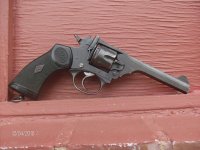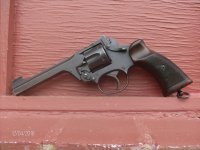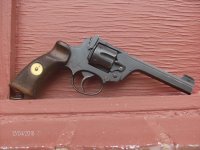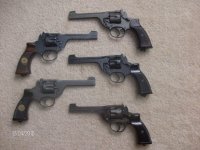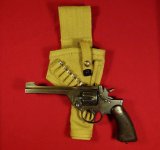dabney
Member
Back in the early 1980's, I became enamored with the WW2-era .380-200 British Enfield No. 2 MK I* Revolver. These break-top wheel guns were a throw-back to the .455 Webley of WW1 times and even further back to the Zulu Wars of the late 1800's. The image of the tall, brave British Officer, armed with his break top Enfield .476 Revolver, standing tall in the face of a fierce Zulu Warrior charge has always captured my imagination. The Enfield Revolvers of WW2 were chambered in the .380 British or our .38 Smith & Wesson cartridge. A short pudgy .38 round traveling at a very modest velocity served the British Military and home defense forces during the war and for many years after. I understand that India, a former Brit colony still uses this cartridge in Ruger Police Service-Six Revolvers for their home defense forces. The Enfield has always been interesting to me as a collector firearm and for a while could be had on the cheap-side. There were but three Enfield makers during WW2, the Enfield Factory itself, Howard Auto Cultivators (HAC) of Sydney, Australia, and Albion Motors of Scotland. These three put out Enfields during the War, with the biggest producer being the Enfield Factory. The Enfields were transferred to former colonial interests after the War, some in use to this day, I'm told. I've managed a modest collection of these British handguns down through the years due to the low cost. Nowadays, a pristine Enfield will bring 300-dollars or more and I keep my best one charged with Remington 145-grain LRN ammo as a house gun. From time to time, I enjoy capping off a few rounds at the range, and under 20-feet, a small group can be obtained. The ultra-reliable Enfield, chambered in .380-200, will make most intruders, with evil intent, leave your property (home) post hast! Drugged up terminators are not included here, cause my old bolt-action JC Higgins 12-gauge Shotgun loaded with No. 7 birdshot stands at the ready (closet). When viewing/examining the Enfield No. 2 MK I*, one notices the difference in craftsmanship and quality between our guns (S&W, Colt) and theirs. Sitting that aside, I love the British Enfield! Nostalgia rules with a tried and true veteran of WW2 for me. I know many wouldn't care for the light-hitting .38 S&W but, and a big but, most two-legged varmints won't take more than 1-hit from the British Enfield before moving, quickly, away from you and yours! Thank you my friends for your patience and kindness here!
David
David


